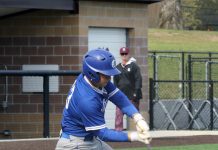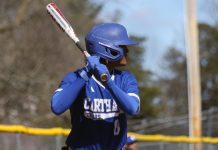Carthage students have been out of the classroom since March and teachers and administrators are eager to get them back and learning — but the novel coronavirus is still circulating and the question remains how to do it without endangering the health of students, teachers, staff and the community.
The Carthage R-9 School District released a plan to do that called “Tigers Together – Safe & Well,” on Friday on its Facebook page and website www.carthagetigers.org.
The plan covers nine topics, academics, social/physical distancing, breakfast and lunch, cleaning and disinfecting, health screenings, parents and visitors, face coverings, transportation and extracurricular activities.
Superintendent Mark Baker talked about the effort and the difficulty of creating this plan at the regular school board meeting on July 20.
“We have been discussing these items since spring break,” Baker said. “We had staff members in through the summer, community members, discussions. We have learned a lot from these discussions we had. We just listened to people and we’re developing this plan and it’s time to release it, even though it’s still fluid. We still need to release a plan so parents and staff can kind of understand what our ultimate goal is and how we’re going to get there.”
COVID education
Baker told the board that discussions among teachers staff and administrators focused on three main issues with regard to bringing students back to school in a pandemic — COVID education, social or physical distancing, and personal protective equipment or face masks.
He stressed that education about the coronavirus and COVID-19, the disease caused by the novel virus, has to start at home.
“Parents and staff have to realize and have to pay attention to symptoms,” Baker said. “We will not stress perfect attendance this year. Perfect attendance is good for the workforce, sometimes you have to go to work when you are sick. There’s no doubt, we’ve all done that before. But in this case, we cannot focus specifically on perfect attendance because we have to pay attention to symptoms.”
Part of COVID-19 education is stressing the need for cleanliness.
“We will have extra cleaning, we will overemphasize hand washing,” Baker said. “Honestly, all the things we should be doing anyway, we’re going to overemphasize, we need to remind even the adults.”
Distancing
Baker talked about how the recommendations from the federal Centers for Disease Control and Prevention have changed through the course of the pandemic.
“You had six foot social distancing for 15 consecutive minutes, some say it’s 15 minutes as a whole,” Baker said. “Just within the last week it came out, oh, three to six feet is fine for social distancing. As we go through all our plans, it’s hard to develop a straight, this is the plan, because things change.”
He said regardless of the recommendations, strict six-foot physical distancing at all times, including in busses and busy hallways, was simply not possible.
“Regardless of the definition, we will not be 100 percent social distancing,” Baker said. “And we’ll tell this to our parents, if you want your kids 100 percent social distancing, don’t send them to Carthage school. It’s impossible to do school the proper way and educate our kids more than six feet apart all the time.”
He said the national guidelines say in order to maintain six-foot distancing on a school bus, only 12 students should be allowed on a bus at one time.
“It would be impossible for us to transport 12 kids on a bus when we transport 2,000 kids a day,” Baker said. “We wouldn’t have enough busses, our routes would start at 4 o’clock in the morning, we wouldn’t have enough drivers, we struggle anyway there. So we will not have social distancing on the bus.”
Social distancing would also be very difficult at building entrances and in the hallways at the junior high and high school.
During breakfast and lunch, students may be eating in their classrooms at times to reduce the crowds in the cafeterias.
“There are other things we will do, but these are examples of things we will struggle with social distancing at six feet apart,” Baker said. “It’s not going to happen all the time.”
Masks
Baker said masks will be a part of the normal school day this year, but they will not be required 100 percent of the time.
He said he won’t expect teachers to police students, especially kindergartners and younger students, with regard to wearing masks during the entire school day.
“Some specific situations, masks on the bus, entering and exiting buildings, maybe have people wear their masks until they get to their classrooms, staff wearing masks until you get to your building,” Baker said. “The age makes a big difference, a high school kid should be able to handle it. As you get a little bit younger, a kindergarten kid might not even put that mask on and feel comfortable.”
He said the district will be flexible and try to accommodate the needs of people with health and special needs students.
“There will be a lot of moving targets we’ll have to hit,” Baker said. Hallways, what we’d like to do is have the kids maybe when they’re passing in the hallways have their masks on because again, you cannot social distance in the hallway. But we will not make anybody wear a mask all day.”
Contact tracing
Baker said teachers, administrators and staff learned a lot about the importance of contact tracing during summer school.
“During the summer it became difficult because we had a lot of positive tests and we tried to track down those kids, who were they around?” Baker said. “The issue I want to make certain everyone understands is any positive test we had during the summer was not transmitted at school. There was no transmission of COVID at school, everything that took place, if we had a positive test, it’s because it came from somewhere else. Not one child, not one adult received COVID because they were at school.”
He said the district will work to keep students in a “bubble” of people with whom they have contact.
“That’s why it’s important to have seating charts,” Baker said. “That’s why it’s important to keep your group together as much as possible, so if you’re going out on recess, you have to know who’s where. Contact tracing will be based around a bubble. Right now, if Billy tests positive, we will look to see who is in his bubble. Has he been within six feet of Karen of Vickie for any substantial amount of time. That’s the bubble we’ll he tracking.”
Online option
Even with these precautions, Baker said he understands that some parents may feel that the risk is too great to send children to school.
He said the district is offering an “online/virtual learning” option for those families.
“If you’re not comfortable, we’ll help you, we’ll teach your kids online,” Baker said. “This is a very difficult, emotional decision students and parents will have to make. Obviously the best thing for children is to be in school. Now the adults need to determine how to make that as safe as possible. If the parents still feel that it’s not safe enough for the children to go to school, we will support them by offering online/virtual learning.
Baker said teachers and staff had to adjust on the fly to offer online instruction back in March, April and May.
Over the summer, teachers, staff and administrators revamped their teaching on all levels to make Carthage’s curriculum accessible online.
“If they’re not comfortable sending their child to school, parents can choose the online/virtual learning option,” Baker said. “Online, we will have R-9 staff monitor and assess those who are using the online/virtual approach. Students will still take Carthage tests, state assessments and federal assessments even if they’re online/virtual.We also had staff members work the last two months to refocus our efforts to match the standards we need our kids to know. We will use Odysseyware and staff-driven curriculum and instruction as part of the online/virtual education.”
Tigers_Together_Safe_and_Well_Final



















